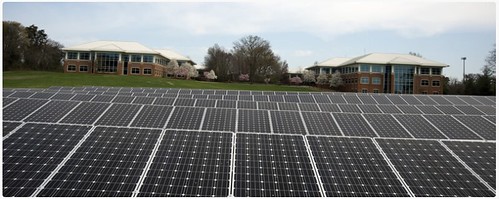
The 1.6 Megawatt solar farm, located at the George Washington Carver Center in Beltsville, Maryland, helps position USDA to meet President Obama’s Executive Order goal to increase the share of electricity the Federal Government consumes from renewable.
In 2015, USDA launched the answer to President Obama’s Climate Action Plan challenge for food and forestry, with the Building Blocks for Climate Smart Agriculture and Forestry. Ten building blocks span a range of technologies and practices to reduce greenhouse gas emissions, increase carbon storage and generate clean renewable energy. Through the Department’s voluntary and incentive-based conservation and energy programs, USDA and its partners are moving forward to reduce net emissions and enhance carbon sequestration by over 120 million metric tons of CO2 equivalent per year, or about 2 percent of economy-wide net greenhouse emissions, by 2025. This reduction is the equivalent of taking 25 million cars off the road or offsetting the emissions produced by powering nearly 11 million homes per year.
In keeping with these efforts, USDA too is working to reduce its own carbon footprint. USDA is proud to be part of the Green Power Partnership, a voluntary program that encourages organizations to use green power as a way to reduce the environmental impacts associated with electricity use. And USDA is even more proud to be recognized as number five on the U.S. Environmental Protection Agency’s (EPA’s) Top 10 Federal Government list of the largest green power users from the Green Power Partnership. Additionally, USDA is number 43 on the National Top 100 list.
USDA is using more than 169 million kilowatt-hours (kWh) of green power annually, which represents 35 percent of its total power needs. And USDA is generating green power from on-site renewable energy including: solar, wind, biomass, hydro and geothermal systems. Because USDA is using green power to advance the green power market and support clean renewable energy alternatives, USDA becomes more sustainable, while also sending a message to others across the United States that using green power is a sound business decision and an important tool in reducing one’s carbon footprint in the fight against climate change.
According to EPA, USDA’s green power use of more than 169 million kWh is equivalent to avoiding the carbon dioxide (CO2) emissions from electricity use of nearly 15,500 average American homes annually. USDA is leading by example for its green power use and for advancing on-site generation.
Green power is zero-emissions electricity that is generated from environmentally preferable renewable resources, such as wind, solar, geothermal, biogas, eligible biomass, and low-impact hydro. Using green power helps build demand for the development of new renewable energy capacity nationwide and helps users reduce their carbon footprints.
In addition to purchasing green power, USDA employs various other sustainable strategies as part of the Department’s operations and practices; including, using alternative fuels in vehicles, designing and constructing high performance green buildings, green purchasing and promoting the use of biobased products. To learn more about USDA’s sustainable operations, please visithttp://greening.usda.gov/.
Currently, this Partnership has more than 1,400 partner organizations that voluntarily use billions of kilowatt-hours of green power annually. Partners include a wide variety of leading organizations such as Fortune 500® companies; small and medium sized businesses; local, state, and federal governments; and colleges and universities. For additional information, please visithttp://www.epa.gov/greenpower.
More information about USDA’s efforts and the results for How Food and Forestry Are Adapting to a Changing Climate is available at https://medium.com/usda-results/how-food-and-forestry-are-adapting-to-a-changing-climate-2f5b84bff9c0#.dn5gf01un.
No comments:
Post a Comment
Note: Only a member of this blog may post a comment.